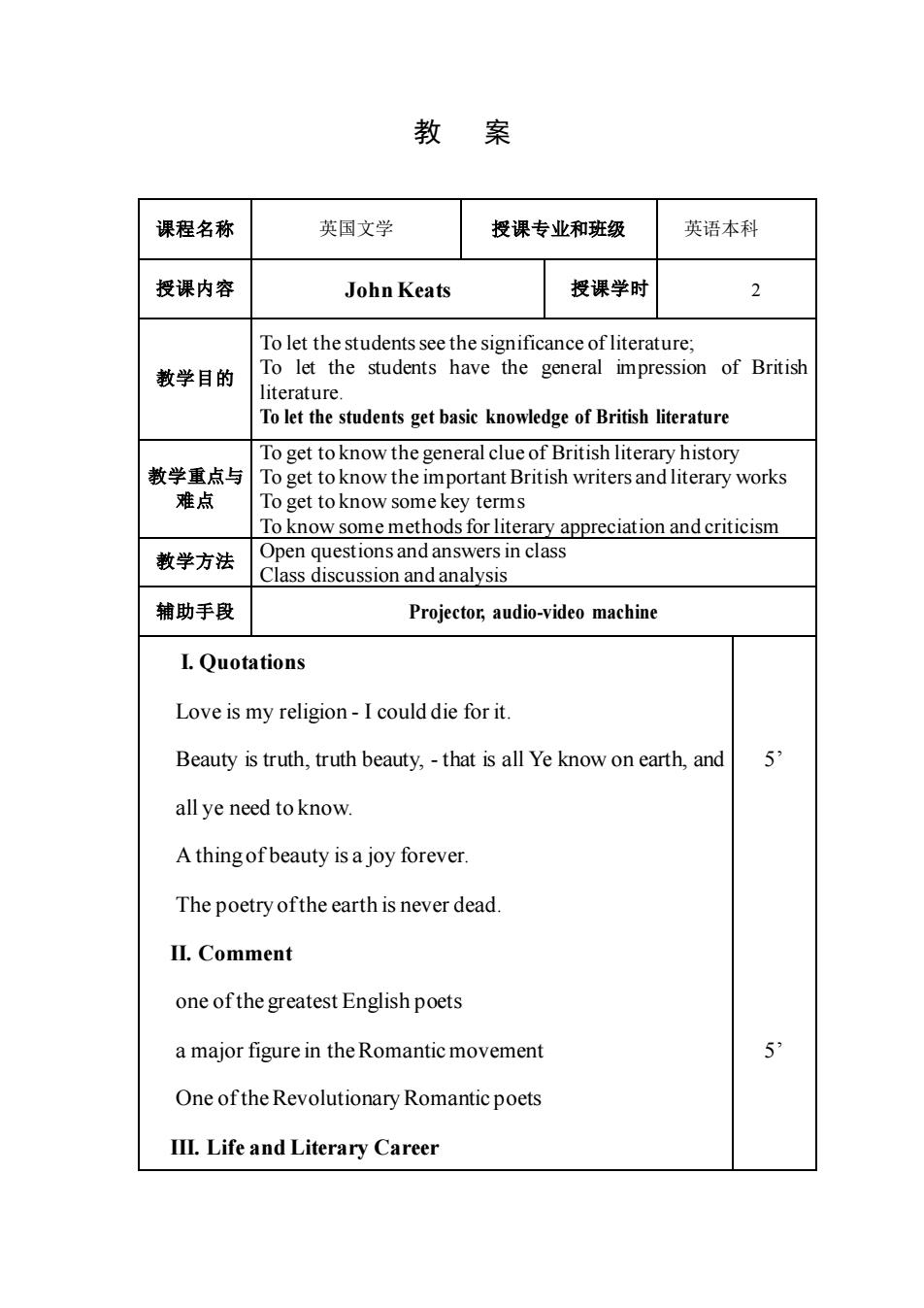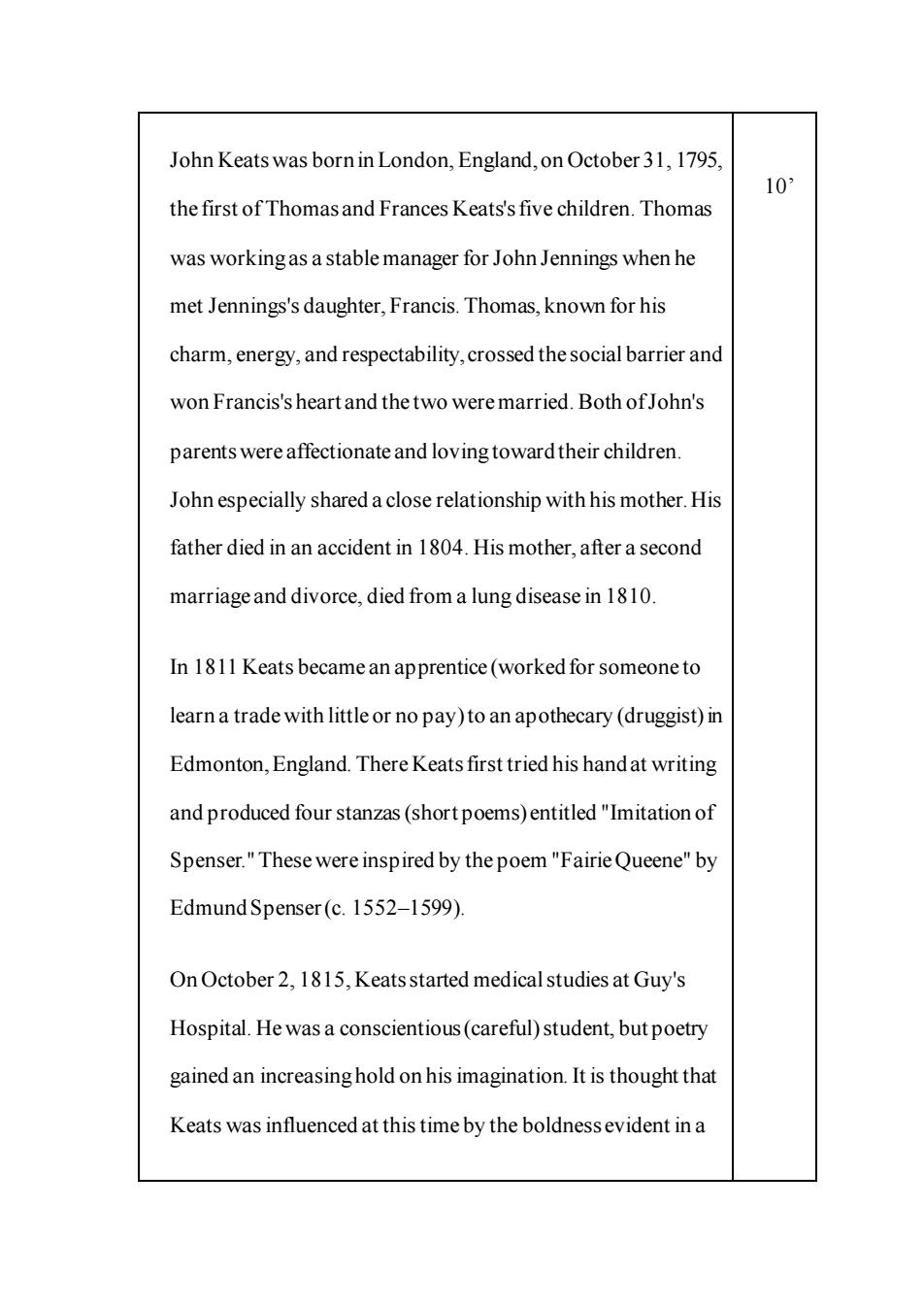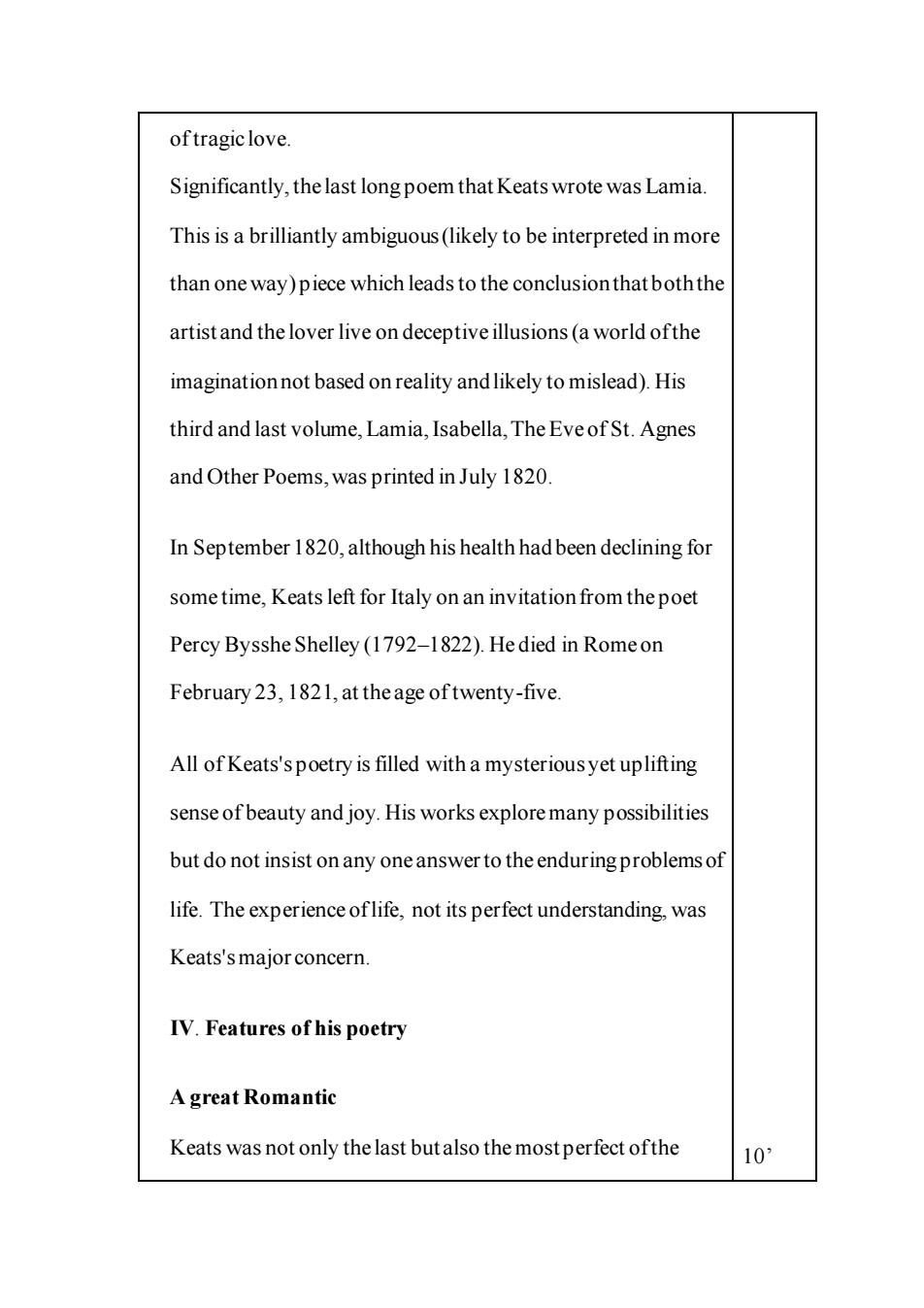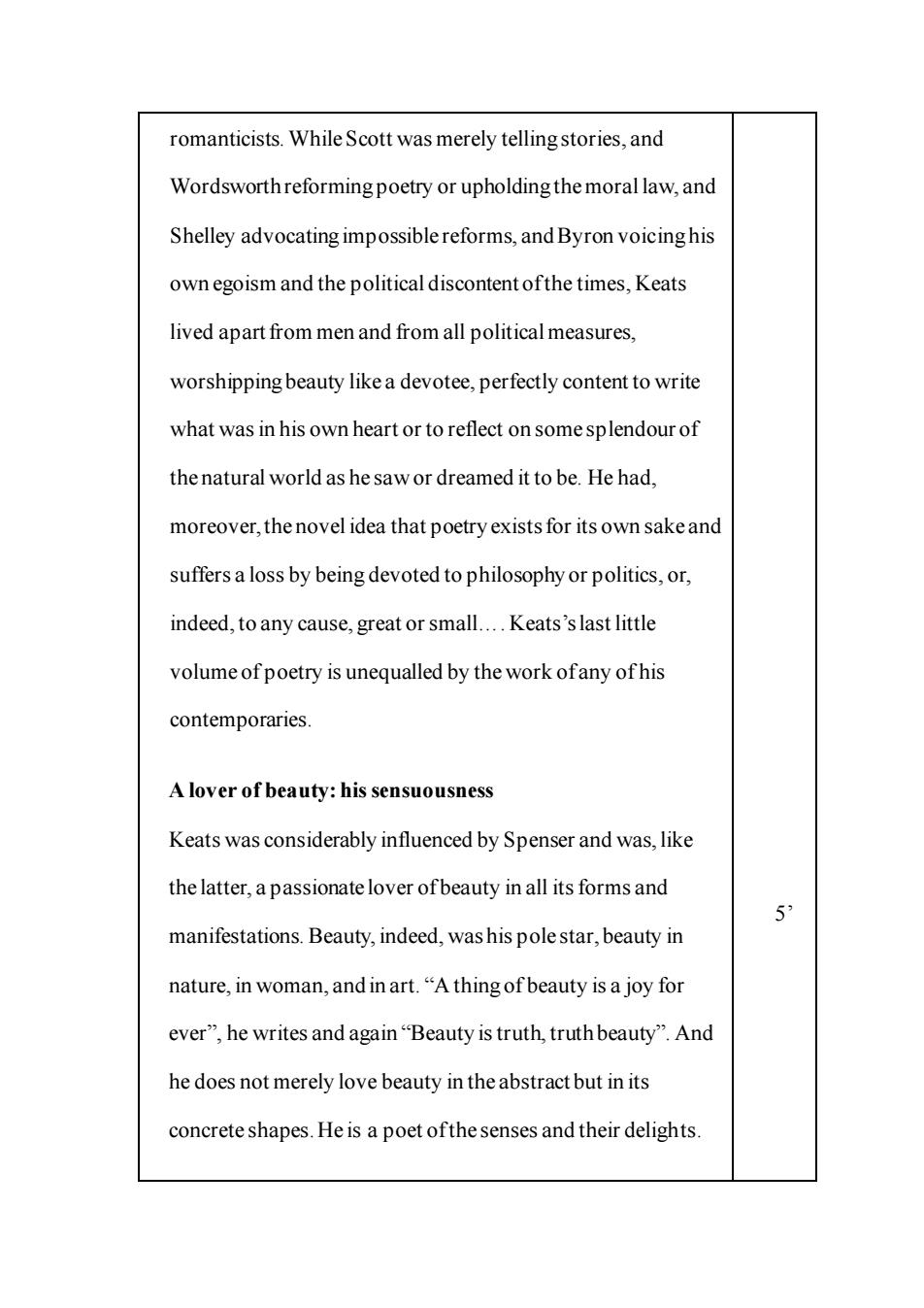
教案 课程名称 英国文学 授课专业和班级 英语本科 授课内容 John Keats 授课学时 To let the students see the significance of literature; 教学目的 To let the students have the general impression of British To get to know the general clue of British literary history 教学重点与To get to know the important British writers and literary works 难点 To get to know some key terms To know some methods for literary appreciation and criticism 教学方法 Open questions and answers in class Class discussion and analysis 辅助手段 Projector,audio-video machine I.Quotations Love is my religion-I could die for it. Beauty is truth,truth beauty,-that is all Ye know on earth,and 5 all ye need to know. A thingof beauty is a joy forever. The poetry ofthe earth is never dead II.Comment one of the greatest English poets a major figure in the Romantic movement 5 One ofthe Revolutionary Romantic poets III.Life and Literary Career
教 案 课程名称 英国文学 授课专业和班级 英语本科 授课内容 John Keats 授课学时 2 教学目的 To let the students see the significance of literature; To let the students have the general impression of British literature. To let the students get basic knowledge of British literature 教学重点与 难点 To get to know the general clue of British literary history To get to know the important British writers and literary works To get to know some key terms To know some methods for literary appreciation and criticism 教学方法 Open questions and answers in class Class discussion and analysis 辅助手段 Projector, audio-video machine I. Quotations Love is my religion - I could die for it. Beauty is truth, truth beauty, - that is all Ye know on earth, and all ye need to know. A thing of beauty is a joy forever. The poetry of the earth is never dead. II. Comment one of the greatest English poets a major figure in the Romantic movement One of the Revolutionary Romantic poets III. Life and Literary Career 5’ 5’

John Keats was born in London,England,on October31,1795 10 the first of Thomas and Frances Keats's five children.Thomas was workingas a stable manager for John Jennings when he met Jennings's daughter,Francis.Thomas,known for his charm,energy,and respectability,crossed the social barrier and won Francis's heart and the two were married.Both of John's parents were affectionate and loving towardtheir children. John especially shared a close relationship with his mother.His father died in an accident in 1804.His mother,after a second marriageand divorce,died from a lung disease in 1810. In 1811 Keats became an apprentice(worked for someone to learn a trade with little or no pay)to an apothecary(druggist)in Edmonton,England.There Keats first tried his handat writing and produced four stanzas(shortpoems)entitled"Imitation of Spenser."These were inspired by the poem"FairieQueene"by EdmundSpenser(c.1552-1599). OnOctober 2,1815,Keatsstarted medicalstudies at Guy's Hospital.He wasa conscientious(careful)student,but poetry gained an increasing hold on his imagination.It is thought that Keats was influenced at this time by the boldnessevident in a
John Keats was born in London, England, on October 31, 1795, the first of Thomas and Frances Keats's five children. Thomas was working as a stable manager for John Jennings when he met Jennings's daughter, Francis. Thomas, known for his charm, energy, and respectability, crossed the social barrier and won Francis's heart and the two were married. Both of John's parents were affectionate and loving toward their children. John especially shared a close relationship with his mother. His father died in an accident in 1804. His mother, after a second marriage and divorce, died from a lung disease in 1810. In 1811 Keats became an apprentice (worked for someone to learn a trade with little or no pay) to an apothecary (druggist) in Edmonton, England. There Keats first tried his hand at writing and produced four stanzas (short poems) entitled "Imitation of Spenser." These were inspired by the poem "Fairie Queene" by Edmund Spenser (c. 1552–1599). On October 2, 1815, Keats started medical studies at Guy's Hospital. He was a conscientious (careful) student, but poetry gained an increasing hold on his imagination. It is thought that Keats was influenced at this time by the boldness evident in a 10’

translation by George Chapman(c.1559-1634)ofthe Odyssey by the Greek poet Homer(c.850 B.C.E.)His first volumeof poems was published in March 1817. Keats's next work,Endymion:A Poetic Romance,was published in May 1818.Keats turned the story ofEndymion,a mythical shepherd,into an allegory(a narrative in which abstract ideas are represented by people)ofthe romantic longing to overcome the boundaries ofordinary human experience.Endymion realizes that ultimate identification with transcendence(risingabove the universe)is to be achieved through humble acceptance ofhuman limitations and ofthe misery built into man's condition.Keats's lettersreveal thatat this time several ofhis friends were ill.His brother was very unwell,and he himself,after a bad cold,prophetically (foretellingly)feared in October 1817that"Ishall never be again secure in Robustness(health and strength)." In early 1818 Keats turned to straightforward narrative in Isabella,which is based onastory by Boccaccio(1313-1375). Its theme was connected with Keats's more philosophical 10 (pertainingto inquiry concerningthesourceand nature of human knowledge)preoccupations-the beauty and greatness
translation by George Chapman (c. 1559–1634) of the Odyssey by the Greek poet Homer (c. 850 B.C.E. ). His first volume of poems was published in March 1817. Keats's next work, Endymion: A Poetic Romance, was published in May 1818. Keats turned the story of Endymion, a mythical shepherd, into an allegory (a narrative in which abstract ideas are represented by people) of the romantic longing to overcome the boundaries of ordinary human experience. Endymion realizes that ultimate identification with transcendence (rising above the universe) is to be achieved through humble acceptance of human limitations and of the misery built into man's condition. Keats's letters reveal that at this time several of his friends were ill. His brother was very unwell, and he himself, after a bad cold, prophetically (foretellingly) feared in October 1817 that "I shall never be again secure in Robustness (health and strength)." In early 1818 Keats turned to straightforward narrative in Isabella, which is based on a story by Boccaccio (1313–1375). Its theme was connected with Keats's more philosophical (pertaining to inquiry concerning the source and nature of human knowledge) preoccupations—the beauty and greatness 10’

oftragic love. Significantly,the last long poem that Keats wrote was Lamia. This is a brilliantly ambiguous(likely to be interpreted in more than one way)piece which leads to the conclusion that boththe artist and the lover live on deceptive illusions(a world ofthe imaginationnot based on reality and likely to mislead).His third and last volume,Lamia,Isabella,The EveofSt.Agnes and Other Poems,was printed in July 1820. In September 1820,although his health had been declining for some time,Keats left for Italy on an invitation from the poet Percy Bysshe Shelley(1792-1822).He died in Romeon February 23,1821,at theage oftwenty-five All of Keats's poetry is filled with a mysteriousyet uplifting sense of beauty and joy.His works explore many possibilities but do not insist on any oneanswer to the enduringproblemsof life.The experience oflife,not its perfect understanding,was Keats's major concern. IV.Features of his poetry A great Romantic Keats was not only the last butalso the most perfect ofthe 103
of tragic love. Significantly, the last long poem that Keats wrote was Lamia. This is a brilliantly ambiguous (likely to be interpreted in more than one way) piece which leads to the conclusion that both the artist and the lover live on deceptive illusions (a world of the imagination not based on reality and likely to mislead). His third and last volume, Lamia, Isabella, The Eve of St. Agnes and Other Poems, was printed in July 1820. In September 1820, although his health had been declining for some time, Keats left for Italy on an invitation from the poet Percy Bysshe Shelley (1792–1822). He died in Rome on February 23, 1821, at the age of twenty-five. All of Keats's poetry is filled with a mysterious yet uplifting sense of beauty and joy. His works explore many possibilities but do not insist on any one answer to the enduring problems of life. The experience of life, not its perfect understanding, was Keats's major concern. IV. Features of his poetry A great Romantic Keats was not only the last but also the most perfect of the 10’

romanticists.WhileScott was merely tellingstories,and Wordsworthreforming poetry or upholdingthe moral law,and Shelley advocating impossible reforms,and Byron voicinghis own egoism and the political discontent ofthe times,Keats lived apart from men and from all political measures, worshipping beauty likea devotee,perfectly content to write what was in his own heart or to reflect on some splendour of thenatural world as he saw or dreamed it to be.He had, moreover,the novel idea that poetry exists for its own sakeand suffers a loss by being devoted to philosophy or politics,or, indeed,to any cause,great or small.Keats'slast little volume of poetry is unequalled by the work ofany of his contemporaries. A lover of beauty:his sensuousness Keats was considerably influenced by Spenser and was,like the latter,a passionate lover ofbeauty in all its forms and manifestations.Beauty,indeed,washis polestar,beauty in nature,in woman,and in art."A thing of beauty is a joy for ever",he writes and again"Beauty is truth,truth beauty".And he does not merely love beauty in theabstract but in its concrete shapes.He is a poet ofthe senses and their delights
romanticists. While Scott was merely telling stories, and Wordsworth reforming poetry or upholding the moral law, and Shelley advocating impossible reforms, and Byron voicing his own egoism and the political discontent of the times, Keats lived apart from men and from all political measures, worshipping beauty like a devotee, perfectly content to write what was in his own heart or to reflect on some splendour of the natural world as he saw or dreamed it to be. He had, moreover, the novel idea that poetry exists for its own sake and suffers a loss by being devoted to philosophy or politics, or, indeed, to any cause, great or small. Keats’s last little volume of poetry is unequalled by the work of any of his contemporaries. A lover of beauty: his sensuousness Keats was considerably influenced by Spenser and was, like the latter, a passionate lover of beauty in all its forms and manifestations. Beauty, indeed, was his pole star, beauty in nature, in woman, and in art. “A thing of beauty is a joy for ever”, he writes and again “Beauty is truth, truth beauty”. And he does not merely love beauty in the abstract but in its concrete shapes. He is a poet of the senses and their delights. 5’